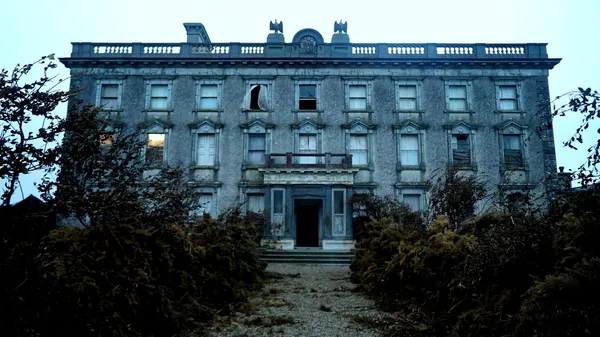 |
| Loftus Hall, the haunted house where The Lodgers was shot |
Twin siblings isolated in a crumbling mansion deep in the Irish countryside. A sinister presence watching them, stealing a little closer every night. Dark secrets, a curse, and unexpected romance. The Lodgers is a chilling slice of old fashioned Gothic horror, and it's one of the offerings at this year's Glasgow Film Festival. I asked director Brian O'Malley if he approached it as part of the recent genre revival.
"I'm a longstanding fan of Gothic period ghost stories," he tells me. "I discovered The Innocents - you know the 1962 film - when I was in my late teens. I always found that type of horror to be about mood and tone and what's implied rather than what's obvious to the camera. I liked some of the more recent film like The Others, The Orphanage and The Devil's Backbone. I find it a really evocative, really cinematic form of cinema and for me this was an opportunity to fulfil my desire to make an entry within that genre... so it was less about what's popular at the moment and more about always wanting to.
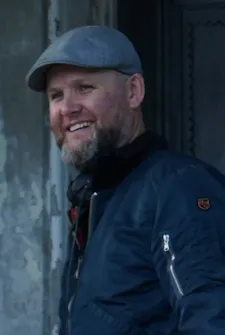 |
| Brian O'Malley |
"After I made Let Us Prey, which is a pretty hardcore violent horror film, I knew I had to cash in on that success. It had done exceptionally well and that gave me a certain market value as a horror director. My favourite genre is science fiction but I also love westerns and thrillers and all of that stuff. I didn't want to be typecast so I was looking for something that fell under the umbrella of horror but showed that I had broader directorial ability. Around the same time the producers were looking for a director for their ghost story and they saw Let Us Prey and enjoyed it so they asked me to read it. What they didn't know was that I was already a massive fan of the genre."
I ask him if it was nerve-racking taking on something on this scale, with so many different component parts to bring together visually on top of the usual work involved.
"I felt very comfortable with it," he says. "I've been making television commercials for 16 or 17 years and you always start with a blank slate, so I'm not fearful about that kind of world building. It's just a question of getting my head down and researching. In an earlier draft the climax was way bigger and more spectacular which was proving problematic because it would have cost almost half the budget, and it became apparent that it wasn't going to happen, so rather that try to do it on a smaller budget and fail miserably, I decided to re-approach the ending."
I ask how he got around some of the other potentially very expensive technical challenges the film presented, such as having water bubble up through the floor of a very expensive house.
That part was actually quite straighforward, mostly due to a stroke of luck that we had," he explains. "Back in the 1990s the house had a leak in the ceiling directly above the foot of the staircase and it destroyed the floor. The hole had just been covered in plywood because the floor would cost €200,000 to repair properly so we just lifted up the plywood and put a tank into the ground, and we laid out a new floor. After we shot those scenes we just let the water trickle down through the gaps and then with a few mops and a few cloths the floor was dry again. If it had been any other house in Ireland we wouldn't have been able do it."
The lake, he says, was more difficult, although he only had to put actors in it for two scenes.
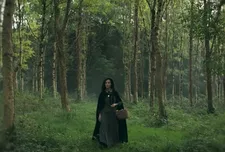 |
| Charlotte Vega in the woods |
"It was freezing, and it was stagnant water because it was a man-made lake, so they had to have chemical showers afterwards. The entire underwater sequence at the end was shot in a swimming pool, or actually in two pools. One was very warm and shallow. We shot in that first, for two days, and then we shot for two days in a pool that was very deep and cold."
He's quick to praise his cast for putting up with it.
"They were really cold over two days. It was tough on us all. Apart from anything else, shooting underwater is at least four time slower than normal shooting so we could only do 10 to 15 shots per day. We had a very strict schedule we had to follow so every shot is in the movie - there isn't anything else. But I think the end result is pretty convincing, if I do say so myself. We had the idea to have them swim into a void so we could shoot against black, which makes things much simpler... but it also looks haunting. I think it suits the picture best and it's something that lends itself to our budget."
I heard a rumour, I say, that the house where they were shooting is supposedly haunted in real life.
"It's considered to be the most haunted house in Ireland," he responds. "It was actually 666 years old when we were shooting - it's 667 now - and it was refurbished 250 years ago. It's a unique house and we felt as if we'd travelled back through time when we went there, because everything about it is authentic from that era, although it's in a poor state of repair. It has a strange presence. Everywhere you look you can see the evidence of the people who lived there before. The wood in the banister is darkened and we worked out that the only thing that could have done that was the oil from many hands, because it's not varnished or waxed. Then there are the floorboards with the imprint of the people who treaded them. You get a great sense of what it must have been like to live in a great house like this all these years ago. It's like you can sense the people who lived there by their absence, and that's a really weird feeling."
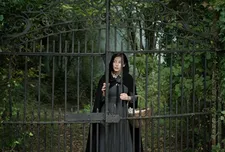 |
| Behind the gates |
The Irish location means that the house has a complicated history which adds a further subtext to the film.
"It's an interesting period that the film is set in - it's 1920, so it's just before Irish independence and four years after the Easter Rising of 1916, so it's an interesting turning point in Irish history. But at that time there wre also Irish soldiers returning from the First World War where they fought alongside the British because they were conscripted into the British army - when they came home they were treated as pariahs and traitors, people looked down their noses at them, like the Sean character [played by Eugene Simon], and then if you go back a few hundred years to when Cromwell invaded Ireland, he actually gave away land to his soldiers and they taxed the peasants and the people who lived there and then with that money they built these colossal houses, the big houses. There were 6,000 of them in Ireland at that point but after the War of Independence most of them were burned down so there are only 600 now.
"But even today people who live in those houses are seen as people who disenfranchised the Irish. So over the years a lot of the landowners created stories and superstitions about the houses to keep people away. It became a form of insurance. So this is really a story that's integral to Ireland and it hasn''t been shown in film yet. It's a fascinating part of Irish history... today [the big houses] don't hold same sense of fear and the hatred that existed towards owners isn't the same but to this day the people who own them are still considered outsiders, and because they kept themselves so separate, a lot of them still speak with English accents."
How involved was he in the casting of the film?
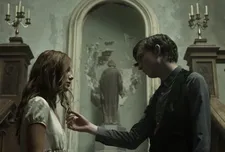 |
| Charlotte Vega and Bill Milner as the troubled twins |
"I was heavily involved in it," he says. "Bill Milner is an actor I've adored since I saw him in Son Of Rambow when he was 10 or 11. When I was casting I had an image of what the character looked like and I wondered what the boy from Son Of Rambow looked like now. I knew he was a brilliant actor and he looked exactly like what I wanted the character to look like.
"Charlotte [Vega, who plays the other twin] was someone I was completely unaware of but one of the producers on the film suggested her and we got her to come. She was blond and a very cheerful kind of person and I thought everything about her was wrong, but then she started acting and it was incredible. In every scene she totally nailed it, she just became the character, and I realised that I had to get over my initial short-sightedness."
Dyeing her hair darker solved one problem and the rest, he says, was all about her skill.
"Whenever we were filming her I completely believed she was the character in the story. Charlotte no longer existed in my mind. And when we got to the end of the scene, when we cut, she'd smile that big smile of hers and she'd be Charlotte again."
The Lodgers is in US cinemas from 24 February and will be screening at the Glasgow Film Festival on 1 March.





















